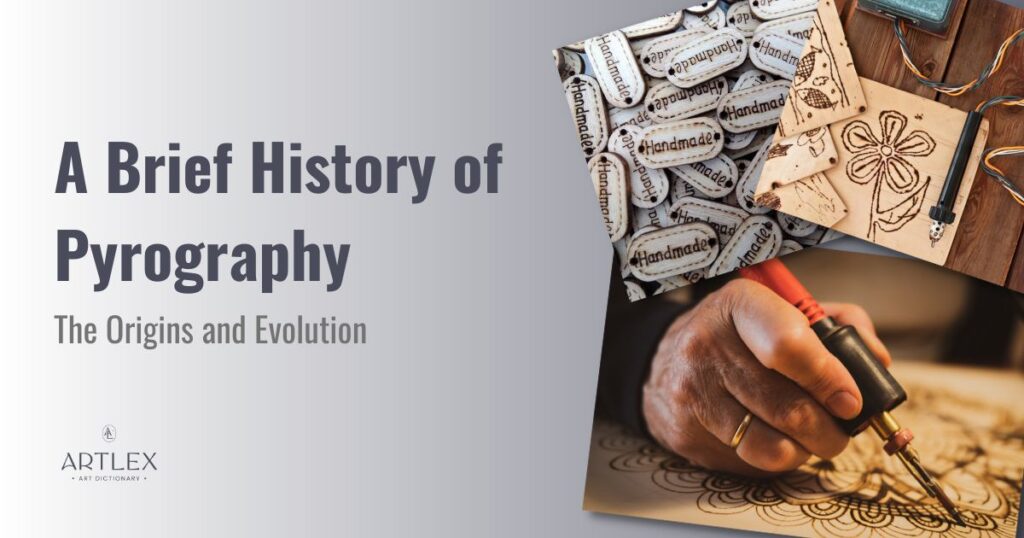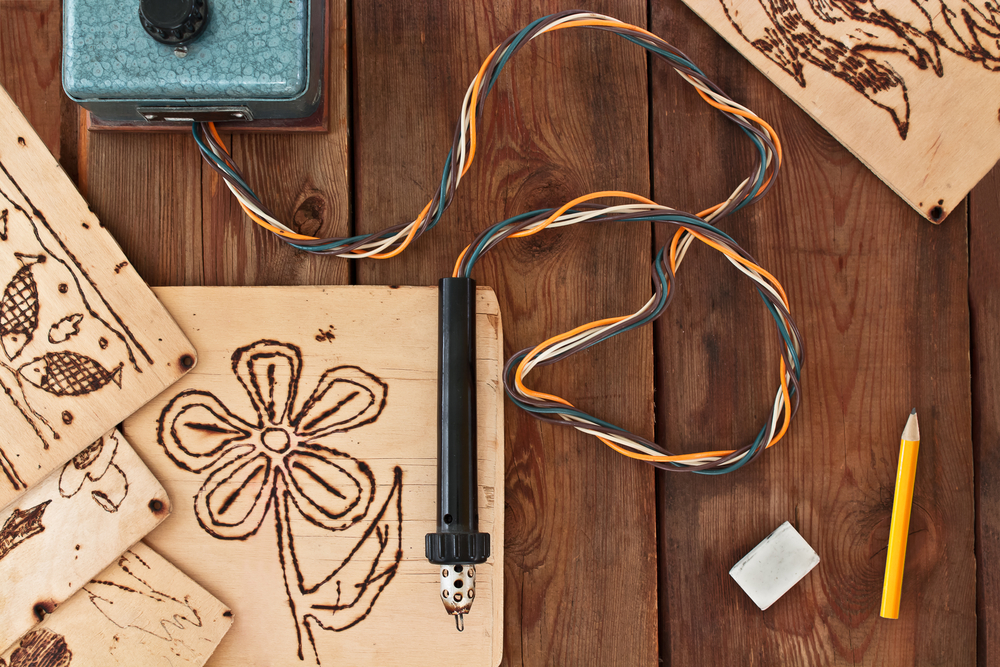
When people make art using wood and fire, the result is pyrography or pyrogravure. This ancient art form is also called pokerwork, and archaeologists have found pieces that date back to prehistoric times.
While the art form began in prehistoric times, inventors developed useful tools. Pyrography machines sparked an interest in the art that men, women, and children have enjoyed it for generations.
What Is Pyrography?
The term pyrography breaks down into pyro and graphy, translating literally into writing with fire. It is an art that includes fire or heat to burn words or drawings into wood or leather. The term pyrography dates back to the Greek ‘pur’ for fire and ‘graphia’ for writing.
In ancient times, artists used smoldering charred wood to decorate their surroundings with pyrography art, burning images into light-colored wood. During the middle ages, people used portable wood stoves to heat several pokers, needles, and knives to create images letting several tools heat up simultaneously.
During the Han dynasty, artists called it fire needle embroidery—referring to the metal implement heated to make art that resembled early needlepoint designs. Later, Victorian inventors built special machines that would burn designs into furniture and other wooden items. As inventors made several tools, pyrography enjoyed a resurgence that continues today.
Now, artists use pyrography tools that heat with electricity. Some people continue to use heated metal, and others use magnifying glasses to burn into the wood with sunlight concentrated on combustible materials like wooden objects or leather.
Technically, all you need is a heated object and some leather or softwood, and you can be a pyrographer, just like the early humans.

Origins of Pyrography
Archaeologists have found evidence of pyrography in ancient Egypt, China, Rome, and Peru. The history of pyrography shows that people used metal rods and charred pieces of still-burning wood to create designs into wood.
As the art form dates back to prehistoric times, archeologists believe the people relied on charred remains for their early pyrography process. After taming fire, early people made burn marks resulting in a method of communication.
The crude form of communication let early people decorate their spaces and leave messages. It took centuries before people realized that a heated metal implement could do the same job as the ancient charred remains. Over the centuries, humans found ways to make pyrography art easier.
Archeologists found that the early civilizations in Peru decorated cups around 700 AD. An early piece from the pyrographic art form comes from the Nazca era in Peru. The piece called the Nazca mate cup has pyrography art that looks like hummingbirds drinking nectar. The piece could have been made using hot coals or a metal tool heated in a fire.
Pyrography During Medieval Times
Artists in the medieval times and middle ages used portable wood stoves to heat their tools. The small stool had lids with holes designed to hold artists’ tools and several pokers. Artists carried several tools with them so they could heat tools while they worked with others.
The history of pyrography and fire needle embroidery shows that blacksmiths during the Middle Ages used knives as a favorite wood-burning tool. Because of their connection to fire and metal tools, blacksmiths decorated their pieces with handmade wood-burning tools. They used wood-burning tools to show their creative workmanship.
Wood burning continued to be a popular method of decorating useful items throughout the 15th and 16th centuries. Wealthy people, nobility, and royalty enjoyed pyrographic designs on chests, panels, and musical instruments. Two remain today in Ireland and Scotland – the Trinity and Queen Mary harps. Due to the nature of the artwork, the older pieces have faded significantly.
As the 1800s began, men were the primary pyrography artists. Later in the century, women became interested in the art, especially as retailers began selling pyrography kits in women’s magazines and other publications. Women used pyrography with an electrical element and popular designs to decorate their homes.
Turn of the Century Pyrography
As the 1900s opened, an architect from Melbourne, Australia, developed an innovative tool for creating pyrographic art. Alfred Smart invented a pyrography pencil that used benzene fumes that moved through the hollow tool. The hollow, platinum pencil stayed hot thanks to the user squeezing a rubber ball that pushed the benzene fumes through it.
With this useful tool, artists could make more ornate designs with shading and tints. Before the invention of the pencil, artists could only make simple designs with limited depth. As the world became electrified, Smart’s pencil did, too. It eventually used an electric high wire to make it easy to etch into the wood.
Once Smart invented the pen, artists could make more ornate pictures on smaller pieces. The pen prompted entrepreneurs to create modern pyrography machines. The art form became so popular that people used them to create pyrographic postcards, and artists would embellish their burn marks with paint and stains.
The wood-burning pen and early pyrography tools sparked an interest in the art form. Turn-of-the-century pyrography tools with metal implements let anyone who could afford them perform pyrography for fun. Widespread interest spread as magazines began showcasing the hobby as a fun thing for women to do.
Between the 1880s and 1920, women ordered their pyrography kits from Sears, Roebuck & Co., and Montgomery-Ward. It became a traditional folk art in South America and many European countries. Women could buy a pyrography workbook filled with amazing art designs for small craft projects.
Modern Pyrography
Modern pyrography machines exist thanks to Alfred Smart and the inventors from the Victorian era. Pyrography continues to be a popular art form because it is accessible to everyone and relaxing. It’s easy to find kits in online stores and brick-and-mortar retailers.
You can purchase ergonomic wood-burning pens with a variety of wood-burning tips for free-handed art. A soldering iron can be used to create wood burning art to create patterns that show your artistic style.
Soldering Irons can be used for Pyrography, but they have some difference with Pyrography pens. See the differences in our article Pyrography Pens vs. Soldering Irons.
Pyrography artists teach wood-burning art at schools, art stores, and through YouTube videos. You can learn traditional pyrography with metal implements heated in the fire. The modern implements make pyrography easier, especially since they have variable temperature controls with an electric current passing directly to wire nib burners.
Stores sell a variety of specialized modern pyrography tools, wood-burning pens, and pyrography technology to make unique pieces in all types of wood and leather. Some people use laser systems for highly detailed designs. Many laser cutters can make mass-produced pyrography pieces like Christmas ornaments and home decor wall art.
You can purchase modern pyrography tools that are outfitted with a stainless steel barrel, a solid brass tip, and other materials that are built with safety in mind. You can import image files from the internet and then use the mechanical tool to make designing pyrography pieces quick and easy.
FAQs
As people continue to learn about the history of pyrography, they often have questions. These are some of the commonly asked questions about the ancient art form that uses heated objects to make the world more beautiful.
When was pyrography first used?
Archeologists have found useful objects decorated with pyrography that show the history of pyrography and wood burning dates back to prehistoric times. The early humans created designs that decorated wood and created patterns on useful items like cups and bowls.
Some wood-burning pieces date back to the 200 AD Han Dynasty in China, while other pyrography dates back as far as the 200 BC to 400 AD Nazca era in Peru.
How did wood burning art start?
The art form dates back to prehistoric times and is one of the oldest human art forms. Archeologists have found wood burning pieces older than the Nazca era of Peru.
In the modern world, the invention of the wood-burning pencil brought pyrography to the masses, especially when magazines published designs for hobbyists to use for inspiration.
Who created wood burning art?
While Alfred Smart did not create wood-burning designs, he did invent a tool that made it easier for the general public to use. His hollow pencil let artists regulate heat so they could create ornate designs. The Smart pencil made wood burning and decorating wood a hobby for people who wanted to purchase kits with the hollow pencil, different tips, and other useful tools.
What is the importance of pyrography?
Pyrography, like ancient cave art, gave ancient people a means to communicate by sharing written words and pictures. They could also use heated tools to create images and enjoy each other’s creativity. It gave people space to decorate their surroundings and learn a relaxing hobby.
Conclusion
Pyrography is a truly global art that has crossed millennia. Pieces decorated with pyrography exist on most continents, and people continue to learn how to make their world more beautiful with intricate wood and leather burning. With the variety of tools available today, pyrography is an affordable hobby that is easy to learn and pass on to your friends and family.
